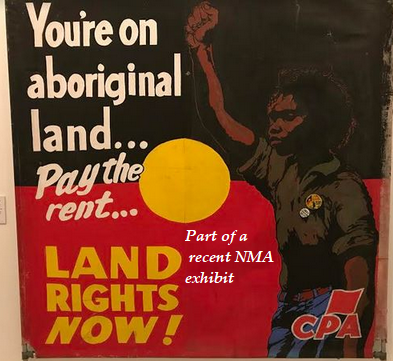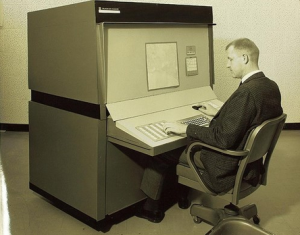
One of the many curious things about Bruce Pascoe’s Dark Emu is its dearth of references to Aboriginal pottery, evidence of which one might expect to be found in profusion. The firing of clay to produce rodent-proof containers for storing grain, as well as cooking pots and drinking vessels, is a hallmark of even the earliest agrarian settlements — settlements of exactly the sort Pascoe claims the explorers encountered.
Find pottery shards and, as archeological evidence everywhere in the world establishes, what the trowels and brushes will have uncovered is a site where former residents had progressed from paleolithic hunter-gatherers to the more settled neolithic lifestyle Pascoe insists Aborigines attained and, indeed, exceeded.
Peter O’Brien eviscerates Dark Emu in his Bitter Harvest.
Order your copy here
This absence of ceramics in the archeological record piqued the interest of a Quadrant reader who, no doubt sporting a mischievous grin, dashed off the note below the National Museum of Australia in Canberra. Why, Sandy asked, was the museum hiding evidence of Aborigines’ mastery of the potter’s wheel and kiln?
Interestingly, a second Quadrant reader, Peter Campion, also wrote to the museum, posed the same question and received an entirely different answer. Why, it’s almost as if the curators of indigeneity and its relics tailor their scholarship and responses according to a correspondent’s perceived sympathies.
Below is the initial enquiry from “Sandy Composta”:
Dear Museum People,
Why won’t you display the pottery crafted by the various Indigenous nations before the First Fleet’s invasion?
Having heard Bruce Pascoe discuss how Aboriginal civilisation has been denigrated and buried by white colonisers, and having also read his equally wonderful book “Dark Emu”, my respect for your museum has shrunk.
On visits I have admired the emphasis your displays give to the Indigenous Holocaust and the culpability of European imperialism in perpetrating genocide.
So why won’t you put the Aboriginal pottery on display? Why have you consigned this proud legacy to the basement?
The suppression of true history continues, as Bruce Pascoe notes.
Please explain so I can pass the information to my mob, who are very angry about this censorship and suppression.
Yours,
Sandy
An initial response from the museum’s “complaints coordinator” was received in short order, our reader reports, with a longer and detailed email arriving within the week. It is reproduced below in its entirety (with emphasis addded):
Dear Sandy,
Thank you for your feedback and thoughts on our permanent exhibition. Please see a response from one of our curators in the Museum’s Indigenous Knowledges centre below:
Over the years, the Museum has displayed shelves of various potteries from Indigenous nations. Collections are periodically rotated for a number of reasons (conservation and to accommodate featuring different stories within the limited spaces). The Open Collections that used to be on display included Aboriginal pottery and other ceramic objects, however, they have been taken off display while the Museum focuses on a complete redevelopment of the First Australians and Torres Straight Islands galleries. These galleries extend across two levels of the Museum and make up a third of the Museum’s permanent gallery space because of the significance of Aboriginal history.
We do hold several collections of Indigenous potteries with other collections coming into the Museum’s collection and display spaces soon.
The Museum has a working relationship with Bruce Pascoe and we collaborate from time to time for workshops. The Museum recognises his in-depth research has taken a long time to come together, and we intend to incorporate new research findings in the gallery redevelopment project.
The current Gallery of First Australians and Torres Strait Islands gallery have experienced a rotation of stories over the years and the Museum, as noted in your email, has never shied away from controversial stories or difficult histories. This practice will continue in the redevelopment project. Consultations have already begun with communities across Australia to showcase the deep and broad representations of Indigenous stories and voices. At the same time, major (and smaller) exhibitions continue to be developed by the Museum which explore specific themes, such as the recent Aboriginal-led exhibition: Songlines: Tracking the Seven Sisters, a 1,000 square metre exhibition, which will begin its national and international tour in 2020, allowing a significant number of audiences to learn about this story.
Since not all of the Museums’ collections can be displayed at any one time, the Museum’s website has a Collection Explorer service, where members of the public can access this database using the internet. http://collectionsearch.nma.gov.au/
We welcome feedback from our visitors and very much appreciate the comments you have provided following your visit. We hope we have answered your questions, and please feel free to let us know if we can provide further information.
Kind regards,
etc etc
A couple of days later, Peter Campion posed the same question and received the very different response below:
Dear Peter
Thank you for your email. There is no pre-1788 Indigenous pottery in the collections of The National Museum Of Australia.
As to whether there is any in existence collected by other public collecting institutions, or private collectors, you will need to inquire with them yourself.
The Museum is unable to conduct research on your behalf, and can only provide information about objects in our collections and research undertaken in relation to our own exhibitions.
Best wishes
Curatorial Inquiries
National Museum of Australia
Just for the record, here are the current members of the museum’s Australia Indigenous Reference Group, whose “primary role” is to provide “expert Indigenous advice to the Council regarding the Museum’s activities that represent and serve the interests of Aboriginal and Torres Strait Islander peoples and the broader Australian community.”
Mrs Fiona Jose (Chair); Mr Tony Calgaret; Mr Aven Noah; Ms Alison Page; Dr Shayne Williams; Ms Zoe Rimmer
They might wish to look into the museum’s “working relationship” with Pascoe.
Then again, they might not.
 Sign In
Sign In 0 Items (
0 Items ( Search
Search










“…focuses on a complete redevelopment of the First Australians and Torres Straight Islands galleries. ”
Torres Strait Islanders are presumably Second Australians and I guess Anglo/Irish are Third Australians,, Chinese Fourth Australians etc.
Just shows what a waste of our money these places are. They lie to the public and boost people who are proven to be liars also.
Is there any truth in the rumour that B Pascoe has pulled out of the Perth Festival at which he was going to be the Keynote Speaker at the Literature & Ideas Weekend 21 February?
If so, why?
At first, I’ll admit it is several years since I visited the National Museum.
Except for one exhibit, I found the collection rather pathetic. In the main display, as I recall, most of the exhibits were of recent origin. Older items were in a separate room that was only opened at particular times, and that collection did not have anything that I would have considered as a wonderful.
That one exceptional exhibit (back in the main display) was about the making of a spearhead using pieces of glass. These pieces were arranged on a post spiralling upwards. Starting at the bottom with a plain piece of glass, each piece showed the progression of the manufacture until the uppermost piece was the completed spearhead.
I was amazed to see such skill was still available so I looked closely to find who had produced it.
It was none other than our renowned anthropologist, Kim Ackerman!
The National Museum is a pathetic, ideology-driven, intellect-free enterprise. The items I’ve seen on display there include a Hills hoist. But I would not be raising the issue of indigenous pottery, because if you do they will surely dig up reports of it, even if the original artefacts cannot be found. Just wait. There will be a team working on this at taxpayer expense right now….
MichaelinBrisbane. According to the festival website he has pulled out because of the bushfires that have devastated his local community at Mallacoota, Vic. Quadrant readers might have thought it had something to do with embarrassment resulting from being exposed as a fabricator of Aboriginal history…
Having lived in the ACT for many years, I have seen the first soil broken in many prominent public buildings. I rate Parliament House as in every way right up there with the Sydney Opera House as one of the architectural wonders of the world. To date, however, I have not been able to bring myself to approach, let alone to visit the ugly “National Museum”. The outrageous shower of sentimental bull**** from the Canberra Times that accompanied its opening was enough to turn the stomachs of the fiercest chauvinist. All first hand reports I’ve heard from friends who have visited have been lukewarm at best and mostly derisory.
The complete failure of Museum anthropologists to speak on this topic and instead keep silent on the 150 years of scholarship they have done would be astonishing – if we hadn’t already seen exactly the same scenario played out by climate specialists who abandoned years of work on the Medieval Warm Period and the Little Ice Age the very moment Michael Mann published his “hockey stick” graph. It appears that there is no integrity left in our academic cliques – more concerned with their continued employment than the rigour of their disciplines
Most indigenous displays I have seen are heavily padded out with Pacific island artifacts or Australian aboriginal artworks produced since the arrival of white man. (For example the Dulux dot paintings on old house doors that are prominently on display in the Adelaide Museum). Take away the Islander pieces and the post 1800 art and theres probably not a whole lot of interest left. Incidently, pottery is also required for one of the most basic of tasks…boiling water.
A very interesting display of Aboriginal relics was on display for many years in the building built to house the Institute of Anatomy. Sadly, that display was dispersed (and probably lost) when the Anatomists were evicted and the building passed to the luvvies to commemorate Auntie Jack and other landmarks of Australian audiovisual “heritage”. Shame.
There is a “Dark Emu” display at the Adelaide Art Gallery. It shows some bogan pick, digging sticks, quandong seeds, grass seeds, some very unappetising yams, etc. with notes from “Uncle Bruce Pascoe”, and some repo’s of “Largest Estate” pictures.
It is surreal that from this collection we are expected to acknowledge indigenous culture as a sophisticated, democratic, agricultural society. It reeks of “The Emperor’s New Clothes.”
To add insult to injury, our own events MUST begin with ‘acknowledging traditional owners’ or something along those lines. Why MUST we do that? Quote, “It reeks of “The Emperor’s New Clothes.” and ‘fungus on the brain’.
Louis Cook, even church services start with those now: deification of aboriginality as a concept!